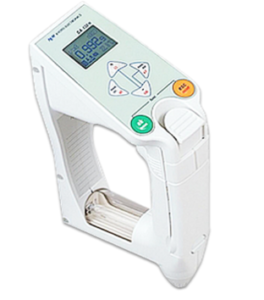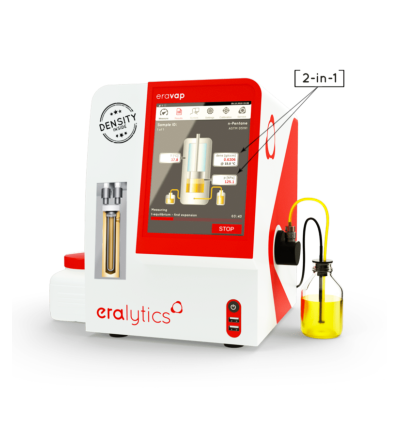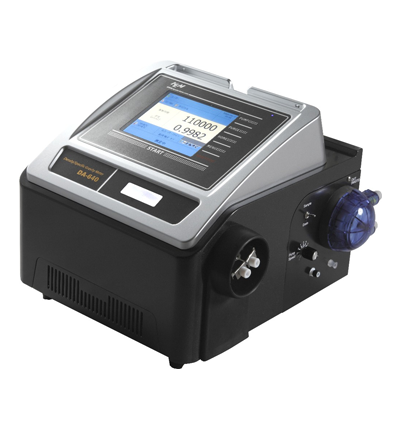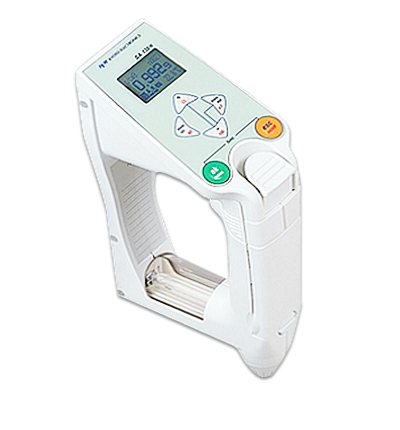ASTM D4052-18a
Standard Test Method for Density, Relative Density, and API Gravity of Liquids by Digital Density Meter
ASTM D4052 covers the determination of density, relative density and API Gravity of petroleum distillates and viscous oils that can be handled in a normal fashion as liquids at the temperature of test, utilizing either a manual or automated sample injection equipment. Its application is restricted to liquids with total vapor pressure (see Test Method D5191) typically below 100kPa and viscosities (see Test Method D445 or D7042) typically below about 15000mm2/s at the temperature of test. The total vapor pressure limitation however can be extended to >100 kPa provided that it is first ascertained that no bubbles form in the U-tube, which can affect the density determination. Some examples of products that may be tested by this procedure include: gasoline and gasoline-oxygenate blends, diesel, jet, basestocks, waxes, and lubricating oils. Refer to the Precision and Bias section of the method and Note 9 for more detailed information about the 1999 ILS that was conducted.
The Density Module ES10 – D4052 is the latest innovation of Eralytics, designed for all the product line to determine density, relative density and API gravity in full compliance to ASTM D4052 standard test method. Based on a state-of-the-art patent pending temperature-controlled U-tube with a precision of 0.0001 g/cm3.
“The Density Meter DA-650 from Kyoto Electronics Manufacturing KEM, is a fast instrument capable of measuring density in only 20 s with a minimal sample of 1.0 mL, designed for all the product line to determine density, relative density and API gravity in full compliance to ASTM D4052 standard test method. Based on a state-of-the-art temperature-controlled U-tube and automatic viscosity correction for high viscosity samples with a precision of 0.00002 g/cm3, which will definitely expand the horizon of fuel, petroleum and petrochemical products characterization.”
The whole product line of KEM density meters and Eralytics modules correlate with all standard test methods ASTM D1250, D1475, D4052, D4808, D5002, D5798, D5931 and ISO standards 12185 and 15212.
Referenced Documents
ASTM Standards:
D287 Standard Test Method for API Gravity of Crude Petroleum and Petroleum Products (Hydrometer Method)
D445 Standard Test Method for Kinematic Viscosity of Transparent and Opaque Liquids (and Calculation of Dynamic Viscosity)
D1193 Specification for Reagent Water
D1250 Guide for Use of Petroleum Measurement Tables
D1298 Standard Test Method for Density, Relative Density or API Gravity of Crude Petroleum and Liquid Petroleum Products by Hydrometer Method
D4052 Standard Test Method for Density, Relative Density and API Gravity of Liquids by Digital Density Meter
D4057 Practice for Manual Sampling of Petroleum and Petroleum Products
D4157 Practice for Automatic Sampling of Petroleum and Petroleum Products
D4377 Standard Test Method for Water in Crude Oils by Potentiometric Karl Fischer Titration
D5002 Standard Test Method for Density, Relative Density and API Gravity of Crude Oils by Digital Density Analyzer
D5191 Standard Test Method for Vapor Pressure of Petroleum Products and Liquid Fuels (Mini Method)
D7042 Standard Test Method for Dynamic Viscosity and Density of Liquids by Stabinger Viscometer (and the Calculation of Kinematic Viscosity)
Summary of Test Method
A volume of 1-2 mL of a liquid sample is introduced manually by means of a syringe or automatically by a controlled pump into an tight temperature controlled oscillating U-tube and the change in oscillating frequency caused by the change in the mass of the U-tube is used in conjunction with calibration data to determine the density, relative density, or API Gravity of the sample.
Significance and Use
Density is a fundamental physical property that can be used in conjunction with other properties to characterize both the light and heavy fractions of petroleum and petroleum products. In this case density or relative density according to D4052 is necessary for the conversion of units of Petroleum and Petroleum Products to complement physical chemical properties of fuels and report weights and volumes at the standard temperature of 15 °C.
Apparatus
A built-in digital analyzer consisting of a U-shaped, oscillating tube, and a system for electronic excitation, frequency counting, and display.
The weight of sample will vibrate in the oscillating U-tube and the measured oscillating period is specific to a substance in proportion to its mass of weight. By this means and since the volume is constant it is possible to determine the density of a substance by measuring the oscillating period.
The analyzer shall accommodate the accurate measurement of the sample temperature during measurement or shall control and keep the sample temperature constant to 60.05 °C. The instrument shall be capable of meeting the precision requirements described in this test method.


Bench Top DA-650 and Portable DA-130N KEM Density/Specific Gravity Meters
The portable density meter DA-130N measures the density in the 0 to 2 g/cm3 with an accuracy of ±0.001 g/cm3.
Quality Control Checks
As a general rule a calibration must be made before any measurement right after the unit is turned on, otherwise it is recommended to calibrate once every 3 days. Confirm the instrument is in statistical control at least once a week when it is in use, by analyzing a quality control (QC) sample that is representative of samples typically analyzed. Analysis of a single QC sample can be sufficient. Analysis of QC sample results can be carried out using control chart techniques. If the QC sample result determined causes the laboratory to be in an out-of-control situation, such as exceeding the laboratory’s control limits, instrument adjustment is required. An ample supply of QC sample material should be available for the intended period of use, and must be homogeneous and stable under the anticipated storage conditions. Prior to monitoring the measurement process, the user of the method needs to determine the average and control limits of the QC sample. The QC sample precision should be checked against the method precision to ensure data quality. Although not mandatory, it is recommended that periodic analyses of certified density standards (that is, traceable to national standards) that are separate from those that may be used in adjusting the instrument, to confirm testing accuracy.
Procedure
The injection of the sample occurs according to the KEM Operation Manual and model. Automated or Manual Syringe Injection in all product line takes precaution for sample integrity and bubbles absence as describied in D4052 Section 12. Follow manufacturer’s instructions for ensuring the integrity of the test specimen prior to analysis, as well as transferring a representative test specimen into the instrument for analysis.
Report
In reporting density, state the test temperature and the units (for example: density at 20 °C = 0.8765 g⁄cm3 or 876.5 kg⁄m3). In reporting relative density, state both the test temperature and the reference temperature, but no units (for example: relative density, 20/20 °C = 0.xxxx). Report the final result for density or relative density to four significant figures and reference D4052 test method. If reporting sample results in API gravity units (see D4052 Note 8), report the final results to the nearest 0.1° API. In some cases, it may be necessary to report if results were based on a single determination or an average of two determinations, as well as if results were determined by manual injection or automated injection to meet specific requirements, such as data recipients wanting to know such information in order to understand how to interpret results relative to the published method precision values. In such cases, it is permissible to report this information along with the test results.
Precision and Bias
The precision of the method as obtained by statistical examination of interlaboratory test results at a test temperature of 15 °C is as follows for the following sample types and ranges:
Repeatability—The difference between successive test results obtained by the same operator with the same apparatus under constant operating conditions on identical test material, would in the long run, in the normal and correct operation of the test method, exceed the following value only in one case in twenty:
Density (g/cm3) and Relative Density—See Table 2.
API Gravity—See Table 3.

Reproducibility—The difference between two single and independent results, obtained by different operators working in different laboratories on identical test material, would in the long run, in the normal and correct operation of the test method, exceed the following values only in one case in twenty:
Density (g/mL) and Relative Density—See Table 4.
API Gravity—See Table 5.







